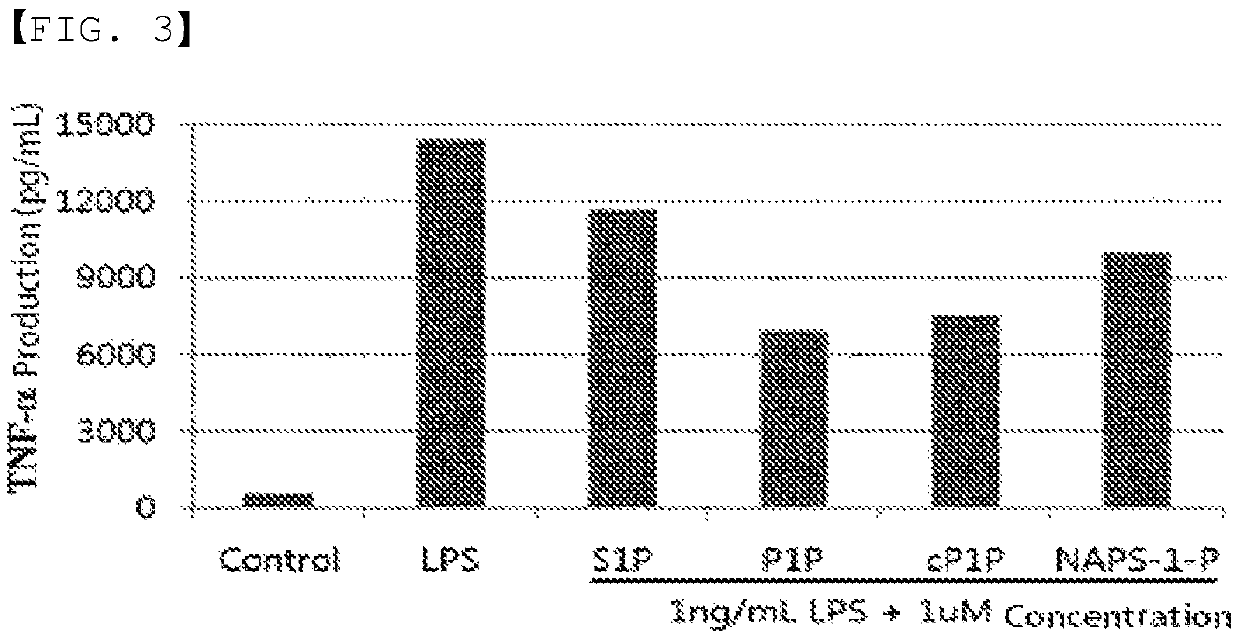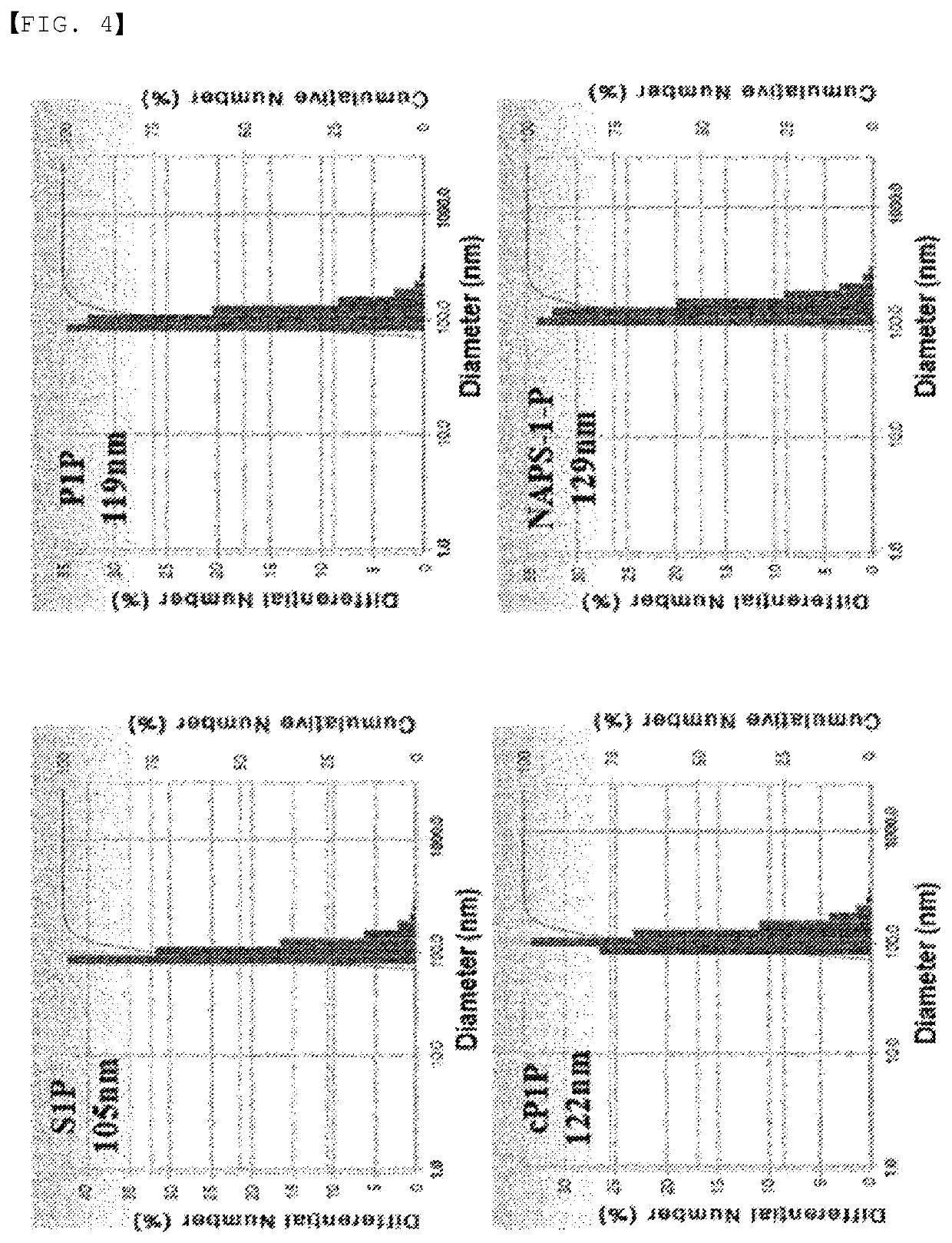Use as immune enhancer or pharmaceutical composition for treatment of dementia, comprising phytosphingosine-1-phosphate or derivative thereof
a technology of phytosphingosine and a derivative, which is applied in the direction of antigen/adjuvant combination ingredients, drug compositions, antigen medical ingredients, etc., can solve the problems of cognitive abnormalities, insufficient immune response due to antigens, and loss of all the functions of daily life, so as to achieve superior th1 immune response inhibiting-ability and antibody producing-ability, and ineffective use in the treatment or prevention of dementia
- Summary
- Abstract
- Description
- Claims
- Application Information
AI Technical Summary
Benefits of technology
Problems solved by technology
Method used
Image
Examples
example 1
Th1 Cytokines in LPS-Stimulated Macrophage Cell Line
[0113]Development of an adjuvant that inhibits the Th1 immune response is essential for the development of an effective AD vaccine. In order to confirm this, an experiment was conducted in which macrophages were stimulated with LPS. When the macrophages were stimulated with LPS, the secretion of TNF-α, a Th1 cytokine, was significantly increased. The results are shown in FIG. 1. As shown in FIG. 1, when stimulated with LPS at a concentration of 1 ng / mL, the secretion of TNF-α, a Th1-type inflammatory cytokine, was significantly increased. In the case of S1P, the secretion of TNF-α tended to decrease slightly in a concentration-dependent manner, whereas, in the P1P-treated group, the secretion of TNF-α tended to decrease significantly in a concentration-dependent manner. In particular, the secretion of TNF-α was significantly reduced in the case of P1P and cyclic P1P (Tables 1-1 to 1-4). As a result of comparing the inhibition rate ...
example 2
ion of Nerve Cell Protecting-Effect of P1P and Antibodies
[0118]Since Alzheimer's disease is caused by cell death due to oxidative stress, the efficacy of the P1P substance against the neuronal cell death due to oxidative stress was measured. The results are shown in FIGS. 2 and 3, and it could be confirmed therefrom that all of P1P, cyclic P1P, and NAPS-1-P have an effect of protecting neuronal cell death induced when treated with 350 μM of hydrogen peroxide. When nerve cells were treated with 350 μM of hydrogen peroxide, about 90% of nerve cells were killed, but when the cells were treated with 100 nM of P1P, cyclic P1P, and NAPS-1-P substances, the nerve cells were not killed (FIG. 2). Therefore, P1P and the derivatives thereof have an excellent effect on the protection of nerve cells induced by oxidative stress and thus can be effectively used as a preventive or therapeutic agent for Alzheimer's disease through protecting cell death.
[0119]The most important factor in Alzheimer's ...
example 3
nt of Particle Size of Liposomal Adjuvants
[0122]Liposomes containing S1P, P1P, cyclic P1P, and NAPS-1-P prepared as described in the experimental methods were prepared, and their particle sizes were measured. S1P, and P1P and the derivatives thereof have no effect on the liposome production itself, and liposome particles were well formed regardless of the presence of S1P or P1P. The particle size of the liposomal adjuvants was measured after sonification, and they had a particle size of about 100 to 120 nm regardless of the types of S1P or P1P (FIG. 4).
[0123]As shown in FIG. 4, it was found that the particle size of the S1P-containing liposome was about 105 nm, the particle size of the P1P-containing liposome was 119 nm, the particle size of the cyclic P1P-containing liposome was 122 nm, and the particle size of the NAPS-1-P-containing liposome was 129 nm, and that these substances had no effect on the change in the particle size. The adjuvants prepared in the form of liposomes acco...
PUM
| Property | Measurement | Unit |
|---|---|---|
| body weight | aaaaa | aaaaa |
| concentration | aaaaa | aaaaa |
| concentration | aaaaa | aaaaa |
Abstract
Description
Claims
Application Information
 Login to View More
Login to View More - R&D
- Intellectual Property
- Life Sciences
- Materials
- Tech Scout
- Unparalleled Data Quality
- Higher Quality Content
- 60% Fewer Hallucinations
Browse by: Latest US Patents, China's latest patents, Technical Efficacy Thesaurus, Application Domain, Technology Topic, Popular Technical Reports.
© 2025 PatSnap. All rights reserved.Legal|Privacy policy|Modern Slavery Act Transparency Statement|Sitemap|About US| Contact US: help@patsnap.com



